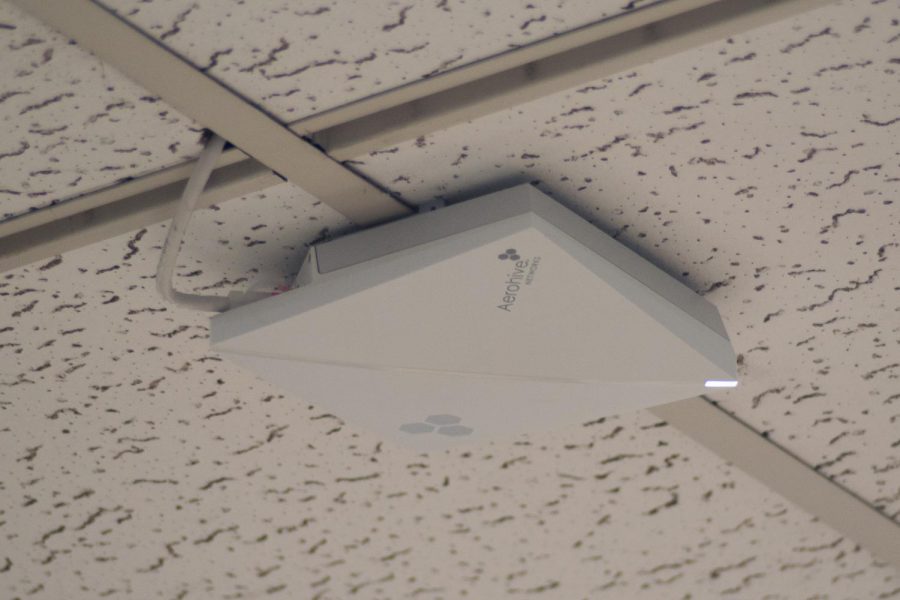La Salle’s Tech Department Addresses Our Wi-Fi Network and How It Operates
At the time of Mr. Shaw’s interview, there were 827 devices connected to La Salle’s Wi-Fi network.
December 8, 2021
At the beginning of the school year, when La Salle’s entire student body was back in the classrooms for the first time since March 2020, La Salle’s technology department began using a new Wi-Fi system that had been implemented throughout the course of the summer. Last summer, the switch from the old configuration to the new one brought a few challenges, especially since La Salle was not operating at full capacity when the switch was made.
La Salle’s Network Systems Administrator is Mr. Tad Shaw, who works with “everything that has to do with technology within the school.” He describes Wi-Fi as “it’s own being or entity,” because Wi-Fi is constantly changing and evolving for the better.
Because of the ever-changing nature of Wi-Fi, La Salle’s system was updated over the summer. The older system that was used at La Salle operated on the 2.4 gigahertz (GHz) Wi-Fi spectrum, with 11 available channels. The new system operates on 5 GHz and 32 channels. GHz represents the frequency of the radio waves. The bigger the frequency, the faster the Wi-Fi speeds.
La Salle’s hardware vendor, Extreme Networks, required that the management system used to manage the Wi-Fi at La Salle be changed. “As part of the transition it kind of made some subtle changes to the wireless configuration across campus,” Director of Technology Mr. David Heineck said.
After this switch, some students and staff have noticed an issue. When moving between rooms, it appears that the Wi-Fi connection is lost.
The AP units in every classroom operate on a channel and can be adjusted to different power settings. The signal from the AP units is stronger the closer a device is to the unit. If the power setting on the AP unit is higher, the signal can remain connected but lose strength.
The problem that students are encountering is that as they move through the halls and pass multiple AP units, their device remains connected to an AP unit that is much further away. Because of the power settings on the units, and the fact that 5 GHz Wi-Fi is not able to easily pass through solid objects, they will remain connected through that channel but the signal will become so weak that it will appear to the student that the connection has been lost entirely.
Mr. Shaw called this a “sticky client.”
The easiest way the student can fix the problem in the moment is by turning their Wi-Fi off and then quickly back on again. Mr. Shaw explained that doing this re-establishes the Wi-Fi connection to the AP unit that is closest to the device. The sticky client will become unstuck.
Lukas Werner
Since 5 GHz Wi-Fi is significantly worse at traveling through barriers like walls than 2.4 GHz Wi-Fi, members of La Salle’s technology team are working to address the problems that come with this new system. The goal is to contain each AP unit’s channel to the walls of its classroom, but the opening of doors within the building can create complications. The signal sometimes leaks out into the hallway and overlap with another signal, creating a sticky client.
Fixing the problem of sticky clients will require adjusting the powers of the AP units to make sure that the signal is contained in each room, a tedious process.
Fixing this issue is just one task on the list of many that Mr. Shaw and Mr. Heineck are addressing. One of their projects includes implementing Wi-Fi 6 within the next one to three years, allowing faster speeds and more reliable connections. “It’s going to involve removing all of our internal network equipment, replacing it with new equipment,” Mr. Heineck said. “Basically doing almost a full scale overhaul of everything to make way for this new technology.”
While there are many other ways that Mr. Shaw spends his time, he prioritizes “the health of our network, that we’re not getting attacked by outside entities,” he said, and that “our systems are connected, that they’re working.” Making sure that students and staff have access to all of our online learning resources is what is most important to Mr. Shaw.
Mr. Shaw and Mr. Heineck both want the La Salle community to know that they can always reach out, stop by the library anytime, or contact them via email using [email protected]. “Even if it’s not a report of something not working super great. Any suggestions, cool ideas, stuff like that would be awesome to hear about,” said Mr. Heineck.






Collins • Dec 10, 2021 at 8:42 am
Very helpful information from you and Mr. Shaw!